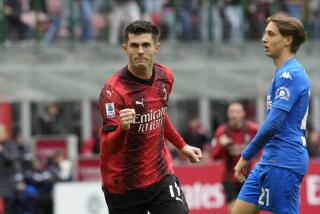Waving a Flag in Support of Turin
- Share via
The first hint I had of World Cup madness came on a somnolent spring afternoon along the shores of Italy’s Lake Como.
The sun was high, glittering at the end of the lake on an Alpine wall of fresh snow. Pansies of purple and gold glowed along the waterfront promenade of Tremezzo, where I sat sipping a cappuccino and reading an International Herald Tribune.
Tremezzo, one of the opera-set villages that rise in steep terraces from the western shore, is painted in ochers and umbers. Cypress and tall pines spear the air, which, on that day, was fragrant with honeysuckle. Clouds of pink rhododendron seemed to float above the gates of private villas.
The soft scene was suddenly rent by blaring horns. A clutch of fast cars careened around a curve. Each was packed with handsome young men who hung out the windows, shouting and waving black and white banners.
Locals hurried from their doors to join the cheers. Youngsters pummeled each other and yelled “Juventus! Juventus!”
That, I learned from the cafe proprietor who had joined the shouting, is the name of a hugely popular soccer team from Turin. It had just won the Italian Cup.
My favorite fan was a not-so-trim waitress who, with a full tray of drinks and glasses, had started across the road between the Hotel Azalea and its minuscule lake front terrace.
When the honking began, she looked right and left and then scurried to her customers’ table--without a spill--before turning to wave her apron and cry: “Juventus.”
I had never visited Turin, but would be there within the week. And from the moment my train pulled into its heart-of-town station, the city felt like a winner.
Turin, the capital of Piedmont, is laid out with wide piazzas and long arcades lined with elegant shops and cafes. High fashion in silk and leather is displayed along the Via Roma in the windows of such revered names as Max Mara, Bruno Magli and Giorgio Armani.
At 263 Via Roma, G.B. Pedrini was showing a tempting array of men’s striped shirts, in colors from salmon to lime. Prices were noticeably lower than in Milan or Rome.
With my luck, however, I arrived at noon and found many boutiques closed for a three-hour siesta. They would re-open about 3:30 p.m., by which time I would be boarding a train to Lyon.
So I wandered around, staring at thickets of Fiats, which are made in this auto-mad city. The name Fiat, in fact, is an acronym for Fabbrica Italiana Automobili Torino. Lancias also are a local product.
At the belle epoque Caffe Torino on the Via Roma, where a grand curving staircase shimmers in gilt and marble, fashionable women were laughing and sipping vermouth, which also is native to Turin. Famous home-grown brands include Cinzano, Martini and Carpano.
Turin has a rich and curious collection of churches, from the Renaissance cathedral Duomo San Giovanni (with its Chapel of the Holy Shroud) to the less visited but grand Church of San Lorenzo on the Piazza de Castello.
Framing the Via Roma, at the south of the Piazza San Carlo, are the matched churches of San Carlo and Santa Cristina. The facade of Santa Cristina is topped with candelabra, like a grandiose birthday cake.
The strangest structure in Turin is called Antonelli’s Mole. Built in the 19th Century, it rises in a jumble of domes, columns and spires. Visitors can take an elevator to the 275-foot level for a panoramic view of both city and Alps. Or so I am told.
I kept my feet on the ground and explored old bookstores, antique shops and the Confettieri Stratta, which smelled of espresso and sweet pastries. From a palette of gelato flavors, I chose a cone of the chocolate-coffee dream called Tira Misu, which translates as “pick me up.”
By then, clouds had pulled over the green hills that sprout at the ends of each street. A drizzle began that soon turned to rain.
If there is any city that is ripe for rain, it is Turin. Thanks to the maze of covered arcades and convenient pedestrian underpasses, I stayed dry on my walk to the train station.
In kiosks near the tracks, shopkeepers were tearing into enormous cardboard boxes of World Cup souvenirs, still confident on that spring day that Italy would take it all.






